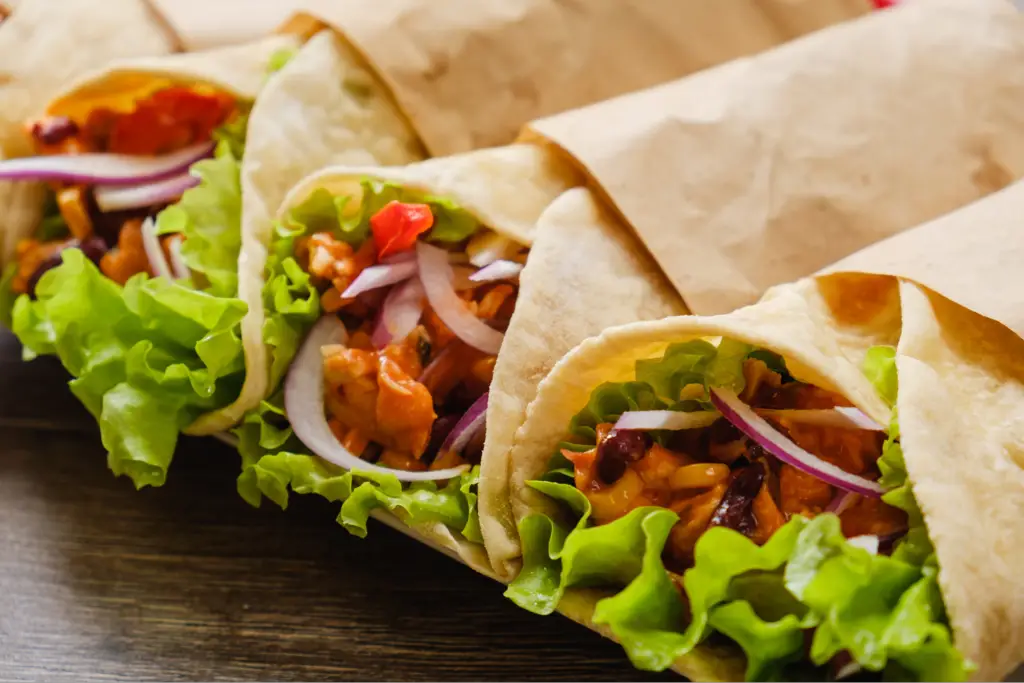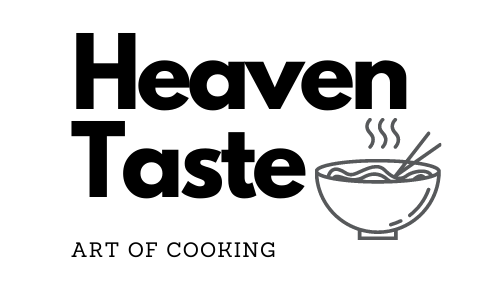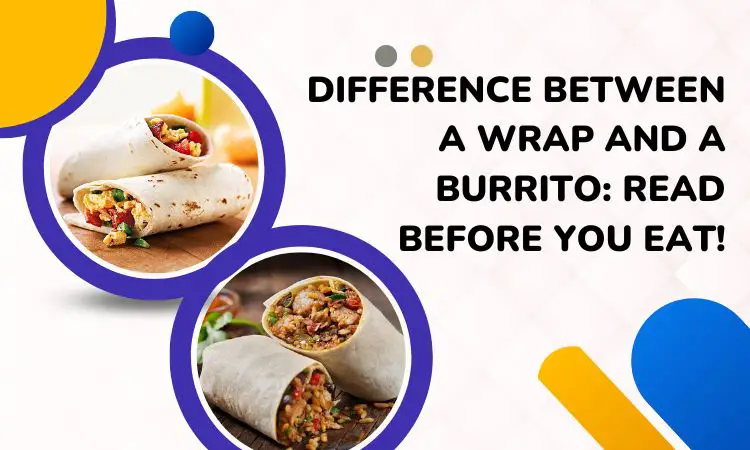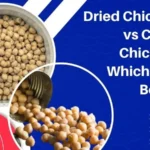Wraps are associated with Mediterranean or Middle Eastern food, while burritos have Mexican roots. Wraps are usually smaller and thinner, while burritos are larger and thicker. Wraps are commonly served cold, while burritos are often served hot. Moreover, Wraps offer limited options like vegetarian, falafel, chicken, salad, and prawn wraps. Burritos have a wider variety including classic, steak, pork, chicken, breakfast, vegetarian, and seafood burritos.
They differ in a number of ways. So, hang tight with the article to get to know them properly. Also, you will learn how to make wraps and burritos.
Key Takeaways
- Burritos have Mexican roots, while wraps are associated with American, Mediterranean or Middle Eastern food.
- Wraps contain yeast, oil, flour, and salt. Burritos are made using unleavened wheat flour tortillas with flour, oil, salt, and water.
- Wrap fillings include roasted vegetables, falafel, chicken, salad, or prawns. You can find seasoned beef, steak, pork, chicken, breakfast ingredients, and vegetarian options in burritos.
- With lighter ingredients like vegetables and lean protein, wraps are generally regarded as healthier. Meat, cheese, and rice make burritos heartier, and they can be higher in calories and fat as a result.
Top 6 Differences Between a Wrap And a Burrito
At first, glance, wraps and burritos might seem strikingly similar, whether you’re comparing their flatbreads or the overall meal.
However, it’s important to recognize that there are significant distinctions between these two options that are worth understanding.
In this section, we will briefly discuss the differences between a Wrap and Burrito before going into more detail.
| Difference | Wrap | Burrito |
| Origin | American, Mediterranean, or Middle Eastern cuisine | Mexican cuisine |
| Flatbread Ingredients | Active dry yeast Warm water Olive oil Whole wheat flour All-purpose flour Salt | Plain wheat flour Vegetable oil Salt Water |
| Size | Thinner and smaller | Bigger and thicker |
| Serving temperature | Cold | Hot, but can be served as cold too |
| Filling | Light condiment and lettuce, Falafel | Meat, cheese, beans, and rice, |
| Meat | Chicken, Turkey, Ham, Roast beef, Bacon | Beef, Chicken, Pork, Steak Chorizo, Carnitas (shredded pork), Barbacoa (shredded beef), Ground beef |
| Health benefits | Healthier | Less healthy |
Now, it’s time to discuss the differences in a broader manner. You will get to know them one by one.
Origin:
Wraps and burritos are distinguished by their origins. Both meals originated in different countries, despite being very common worldwide.
Although both wraps and burritos are enveloped in tortillas, their origins diverge. Burritos are traced back to Mexican roots. Emerging as a favored Tex-Mex delight, it is believed to have its origins in Northern Mexico.

In fact, the wrap sandwich believed to be of American origin, finds its roots, particularly in California, which is recognized as the birthplace of this culinary creation. However, wraps are also typically linked with Mediterranean or Middle Eastern culinary traditions.
Flatbread Ingredients:
The composition of ingredients for wraps varies based on whether they are leavened or unleavened. However, there exists a general similarity in the components used.
For a leavened wrap, like a basic flatbread, the following ingredients are typically involved:
- Active dry yeast
- Warm water
- Olive oil
- Whole wheat flour
- All-purpose flour
- Salt
In contrast, the construction of most burritos involves unleavened wheat flour tortillas. They are straightforward to create due to their reliance on a few common household ingredients:
- Plain wheat flour
- Vegetable oil
- Salt
- Water
Size:
Wraps and burritos differ significantly in size when compared. The overall width and dimensions of wraps are typically smaller and more compact.
Compared to burritos, burritos are much larger and more substantial in size. Wraps are usually thinner than burritos, and burritos are impressively bulkier.
Serving Temperature:
In terms of their serving temperature, wraps, and burritos demonstrate a discernible contrast.
In general, wraps are served chilled, emphasizing their inclination towards a cooler dining experience. Burritos, on the other hand, tend to be served hot, with most in a hot state.
Filling:
The filling of the wrap differs according to the type. Vegetarian wraps offer a light and delightful lunch option. It comes with a particularly harmonious blend that comprises roasted vegetables, pickled onions, and tzatziki. The choice between roasted or fresh vegetables depends on your preference and the overall theme of your wrap.
The Falafel Wrap reigns as one of the most sought-after choices, and rightfully so. The medley of falafel, avocado, herbs, hummus, and tahini creates an almost unbeatable combination.
For those craving the timeless appeal of chicken, the Chicken Wrap steps forward. Begin with shredded chicken, incorporating tomatoes, red onion, avocado, and garlic mayo.
When your refrigerator holds an assortment of leftover salad ingredients, the Salad Wrap emerges as an ingenious solution. Lettuce, rocket, cucumber, onions, grated cheddar, avocado, and hummus harmonize into a balanced blend.
The Prawn Wrap elevates the culinary experience with a touch of elegance. A medley of mayonnaise, ketchup, and tabasco complements the cooked prawns, diced avocado, and chives. Essentially, this is the Americanized wrap.
However, if you are craving to try multicultural cuisine then Gyro and Shawarma are wonderful options to try out. Gyro which originates in Greece is made with lamb, tzatziki sauce, lettuce, tomatoes, and onion.
Whereas across the Aegean Sea in Turkey, you get Durum, which is made with the exact ingredients of a Doner Kebab. Made with Lavash or Yufka flatbread accompanied by beef, lamb, garlic, and onion.
Also from the Middle East, you get the wonderful Shawarma. This is made with everything from lamb to chicken. But the filling option varies by country but typically you get lemon juice, olive oil, salad, and sometimes even French fries.

On the other hand, burritos are filled differently depending on their type.
The Classic Burrito brings together seasoned ground beef, rice, refried beans, shredded lettuce, salsa, sour cream, chili sauce, and, on occasion, cheese.
Then, the Steak Burrito, also known as carne asada, stands as a prominent choice. It showcases marinated grilled steak, complemented by cilantro, diced onion, and the presence of black beans. Labouchere sauce of steak is also sometimes added to spice up the flavor.
The Pork Burrito companions include green chiles, shredded cheese, and rice, a combination that embodies a harmonious interplay of flavors.
Chicken burritos feature shredded chicken, diced onion, and a rich mole sauce that lends a distinct flavor profile. People also turn marinara into sauce to accompany the burritos.
The undeniable deliciousness of breakfast burritos has given them considerable contemporary appeal, even though they are not rooted in tradition. A popular choice includes scrambled eggs, bacon, cheese, tomato, and Tabasco sauce. Various meat options, such as chorizo, sausage, or ham, can be added.
The Vegetable Burrito components include red chile sauce, refried pinto beans, shredded cheese, and optional rice. This offering is elevated when paired with cilantro, salsa, avocado salsa or guacamole, and crema.
In recent years, seafood burritos have become increasingly popular. They usually contain fish, shrimp, crab, or lobster. Along with rice, beans, vegetables, and various seasonings, they are wrapped in a tortilla. Typically, they’re served in Mexican or fusion restaurants.
Health Benefits:
Wraps frequently earn a reputation for being more healthy when pitted against burritos. Wraps tend to feature lighter, fresher ingredients that emphasize nutrient-rich components such as vegetables, lean proteins, and whole grains.
On the other hand, burritos can lean towards heartier fillings that incorporate ingredients like seasoned meats, cheese, and substantial portions of rice and beans. That potentially yields higher calorie and fat content.
After a burrito, it’s like entering a food-induced siesta with your tummy full. Meanwhile, a wrap sets the stage for lively conversation.
How to Make Wrap and Burrito
If you want to make a wrap at home, you can follow the step-by-step procedure given below.
Step 1: Begin with a big flatbread called a tortilla. Put a little bit of filling on the tortilla. Leave more than half of the top part empty and keep a couple of inches free on both sides.
Step 2: Then, fold the sides in a little, so they are close but not touching completely. This way, some of the fillings can still be seen.
Step 3: After that, lift up the bottom part and start rolling. While you roll, keep the side parts tucked in using your thumbs. Pull the bottom part tight and use it to wrap around the filling and side parts, rolling one or two times.
Step 4: Now, spread cream cheese or mayonnaise all over the wrap. This will help keep everything in place, so make sure to cover the edges too. And put meat on the whole wrap, but leave about an inch of space on the sides and the end.
Step 5: Finally, add cheese, bacon, onions, and lettuce to one end of the wrap. And roll up the wrap tightly.
Making a Burrito is also very easy! Follow these steps:
Step 1: Get a big flatbread called a tortilla. If you want, you can even make a big tortilla yourself using a recipe.
Step 2: Put the stuff you like to eat in the middle of the tortilla. Burritos can have things like meat (like chicken, beef, or pork), beans, rice, cheese, veggies, and sauces.
Step 3: Fold in the short ends of the tortilla, the ones that stick out on the sides. This helps to keep the stuff from falling out.
Step 4: With the line of stuff parallel to your body, roll the tortilla really tight from one side to the other to cover the stuff. If you want, you can cut the burrito in half or wrap it in foil to keep it together.
Remember, different people fold burritos in different ways. Some fold the sides of the tortilla before rolling, while others roll it really tight from one end to the other. The important thing is to make sure the stuff inside is all safe and sound. So, make sure you know how to fold burritos like a pro.
Wrap vs. Burrito: Which One Is Better?
There is no shortcut answer to this question. The better one totally depends on your taste and taste. Though Warp and burrito look like same, they are different kinds of sandwiches. Different fillings and origins distinguish them. Burritos are always hot, while Wraps are better as cold sandwiches.
Most importantly, wraps can be healthier than regular burritos. If you want a wider range of variation, Burrito can serve it. However, Wrap has multiple variations as well. Burritos can be considered a wrap sandwich on a broader scale.
Frequently Asked Questions (FAQs):
What Sides Go Well with Burritos?
Burritos can make you feel full all by themselves. But if you want to have something with your burrito, you can pick from options like lime and coriander rice, Mexican corn, Mexican bean salad, or pico de gallo. It’s a good idea to choose something that’s light and fresh to go with your burrito. This will go well with the delicious taste of the burrito.
What’s the Difference Between a Burrito And a Shawarma?
Shawarma usually has roasted meat in a flatbread, while burritos can have meat or not. Burritos use many different things inside, but in shawarma, meat is the main attraction. This makes burritos more flexible, while shawarma is better for people who really like meat.
Is a Burrito a Quesadilla?
No, a burrito is not a quesadilla. The main contrast between a burrito and a quesadilla is how they look. A burrito is shaped like a cylinder, while a quesadilla is more like a complete circle or a half-circle. Also, a burrito is usually filled with more stuff than a quesadilla. It has a lot of ingredients, like meat and veggies, making it heavier.
Conclusion
Now you know each detail regarding the difference between a wrap and a burrito.
You will be tempted to eat both of them because they are both delicious. There are, however, some fundamental differences between them. Depending on your taste and preferences, you should pick one. Regardless of what you choose, you will surely enjoy it.





